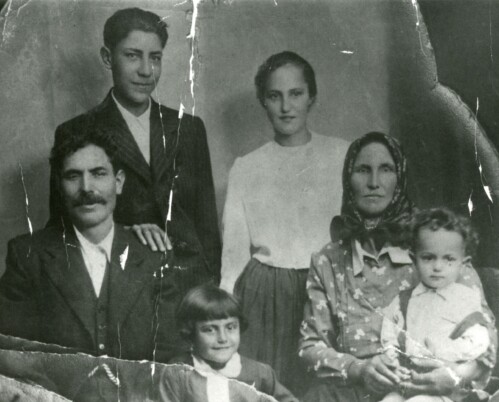
Vlasta Danielová
Vlasta Danielová, née Kierová, born 1925 in the village of Derfle (now part of Sady, Uherské Hradiště)
-
Testimony abstract
Vlasta Danielová was born in Derfle. Her father, Emil Kier, mined sand [on the Morava River (ed.)] for several years; her mother raised and sold poultry. Vlasta had seven siblings - brothers Izidor, Stanislav, Raimund and Jeníček and sisters Matylda, Viktora and Mila. The eldest, Izidor, was a trained bricklayer, Vlasta worked in the brickyard at Mařatice.[1] They lived in a cottage and had very good relations with the local inhabitants and the gendarmes from Kunovice.
- [1] It belonged to the company Josef Štancl and Son. (ed.)
The family could not imagine that they might be subject to similar restrictions as the Jews. Vlasta’s mother, a Slovak, said that if worse came to worst they would flee to Slovakia, but the father said they had no reason to run away as they had not killed anyone. Vlasta’s brothers Izidor and Stanislav were soon sent to forced labour – Izidor to Linz, where he could go home every month on leave, and Stanislav to Dresden.[1] The surrounding Roma began to be taken away in 1942, mainly from Staré Město and mostly to Hodonín u Kunštátu, but the Kiers were still not concerned. It was only when the Germans built a shooting range in the neighbourhood that they had to leave their house and build a new one elsewhere from their own savings. The parents negotiated a pass for Izidor to build it; the builder Šupka gave them the materials. Then [Josef] Štancl[2] began to threaten the family, so they went to work for him, although he did not pay them.
Among the restrictions against the Roma, Vlasta Danielová chiefly mentioned being banned from going to the cinema, which she enjoyed. But the cinema operator defied the regulation and carried on letting her family in.
In March,[3] the family was ordered by the gendarmes to pack food for three days and clothes and to come to the pub in Derfle. About thirty people were gathered there, four families. She remembered in particular the Holomeks. Vlasta’s brother Izidor was home on leave, and although his parents tried to talk him out of it, he said he would go too. They were taken by a vehicle to the Sokol Hall in Staré Město near Uherské Hradiště, where Roma from Hradiště, Veselí nad Moravou, Uherské Ostroh and other villages had already assembled. Their names were written down on a list and their fingerprints taken. Izidor objected to this and was slapped by a police officer, but his mother slapped the officer back, and added an extra slap. Gendarmes from Kunovice, who knew the family well, helped calm the situation.
The next day they were herded into wagons at the Staré Město station. In Ostrava, the Germans took over the transport from the gendarmes, and the train reached its destination [Auschwitz II-Birkenau] after dark. With kicks and curses, and with the help of barking dogs they were driven out of the wagons and lined up; then they walked to the camp. They were put in a barrack where there were only earth floors and where all through the night transports arrived with Roma from Poland, Germany and other countries whose language they did not understand. They were in quarantine for four weeks; food was brought to them by Jews, it was bad, and there was little of it. They had no blankets and no toilet, only barrels. Then they were given a [tattooed] camp number. Their names ceased to exist, she says, from that moment on it was just "Zwölfhundertfünfundfierzig". They were allowed to keep their own clothes, but they were moved into a barrack with brutal Polish kapos who beat them for anything. They had no water and could not wash themselves; they caught rainwater in bowls. It was four months before they were able to bathe.
Diseases spread in the camp, especially typhus. The blocks at the end of the camp were called the Krankenbau and that was where they sent the sick. Vlasta’s father died there first, then her eldest sister Matylda and her youngest brother Jeníček. She herself was there for a short time, and a Polish doctor extracted her tooth.[4]
Vlasta Danielová had to dig drainage gutters, sidewalks and the road to the crematoria. Later she worked in the kitchen, where the manager was a Pole she called “Jaša”[5] from Warsaw; the food was also given out by a Pole,[6] who took Danielová in hand. For the small children it was cooked separately; semolina, custard, or soup. Portions were issued for the number of children in each block, but the kapos and block chiefs took some of it for themselves. When the food was being served and a German was not supervising her,[7] she could give people extra. She was caught once, but got away with only two slaps.
The brothers Izidor[8] and Raimund[9] were then taken on a transport.[10] Vlasta was reunited with Raimund in Auschwitz and was able to give him extra food, but he was soon taken away[11] and they did not see each other again until after the war. She was also able to give extra to her friend from Uherské Hradiště, Robert Schön, a Jewish prisoner, to whom she brought food to the wire fence before the transport took him away as well; they met in Hradiště after the war.
She recalls that when washrooms were built in the camp, the Germans would go to the showers to select persons suitable for experiments. The women were offered release if they had their wombs removed, but no one volunteered.[12]
From the kitchen windows one could see the road leading to the crematorium and the gas chambers. If Blocksperre was announced while Vlasta was still working, she could not return to the block, so she saw vehicles taking people to the crematorium and returning with only their clothes. In the kitchen they also sorted the food that was left in the wagons from the arriving transports. Sometimes they found the valuables of the previous owners in it. Once, when a bag of gold jewellery was discovered while jam-making; it was appropriated by the German supervisor.
She remembered how some Moravian Roma escaped and were caught by the Germans, beaten with whips as examples and finally taken to an unknown destination. One of them, who she said came from Petrov, was shot and carried naked from block to block; everyone had to look at him and say whether they knew him. No one came forward, even his wife denied she knew him out of fear.[13]
She describes how the kapos on the block were German Roma, a married couple with two children, who displayed Hitler's portrait.[14] She also recalls Josef Mengele, who often drove away from the block with two ten-year-old boys, twins, and brought them back by car, but then one time he did not bring them back.
Vlasta Danielová described the most terrible moment in the camp as the evening when the families were ordered to assemble. Some of the prisoners were taken away then, but the Kier family was not selected.[15]
Vlasta Danielová was then placed on a transport to Ravensbrück.[16] Like the other women, she was given a new prison number and a black triangle-shaped patch, which designated prostitutes and work shunners. She recalled a brutal Russian warden called Masha and one of the most rigorous body searches. She was transferred from Ravensbrück to Svatava and then to Kraslice, where they had turned the former textile factory into an arms factory. She worked in shifts, had better accommodation, and could wash at any time. Then, when the Americans bombed Kraslice and the factory, the Germans lined them up and took them on a gruelling death march. Near Karlovy Vary, Vlasta Danielová and several women were released. The trains were returning and at the station in Rakovník they were approached by Josef Hauer from the village of Horní Hradiště, who had a wife and children in the concentration camp. He let them stay there with him for about three weeks before they could go home safely to Moravia.
- [1] This happened on 7 November 1941, when 38 Roma were deployed by the Uherské Hradiště branch of the Labour Office to work in the Reich. (ed.)
- [2] In 1941-1943 Štancl was the mayor of the town; in addition to the pharmacy and brickyard, he also owned fields. (ed.)
- [3] Exact date not given.
- [4] The dentist, himself a prisoner, served in Block 28 and is mentioned in L. Adelsberger, Ein Tatsachenbericht, Berlin 1956, pp. 79-81. (ed.)
- [5] Jan Bromilski, born 24 December 1904, Medyka. (ed.)
- [6] Name not given.
- [7] The kitchen was supervised by SS-Hauptscharführer Wilhelm Händler. (ed.)
- [8] Born 1919.
- [9] Born 1921.
- [10] Transport of 24 May 1944 to the concentration camp at Flossenbürg. (ed.)
- [11] Transport of 2 August 1944 to Buchenwald concentration camp. (ed.)
- [12] See the records of the searches at the SS-Hygienischer Institut, Archiwum Panstwowego Muzeum, Auschwitz-Birkenau, D-SS Hyg. Inst.
- [13] It happened on May 7, 1943, when Jaromír Daniel, born 1918 in Jalubí, Jan Daniel, born 1915 in Hodonín, Antonín Holomek, born 1909 in Milokošt', Štěpán Holomek, born 1908 in Kyjov, and Vincenc Vrba, born 1903 in Zálužany, escaped. The first four were caught on the same day, Vincenc Vrba after seven days. They were executed on 22 May 1943. (ed.)
- [14] He was a wealthy Roma from Leipzig and one of the old Nazi Party members; see R. Höss and P. Broad: Oswiecim w oczach SS, Katovice 1985, pp. 56 and 165.
- [15] One evening after 25 May 1943, 971 Polish Roma from Bialystok and 76 Austrian Roma were taken to the gas chambers because of symptoms of typhus. (ed.)
- [16] She arrived there on August 3, 1944. (ed.)
Vlasta Danielová arrived home on 30 May. She found the house damaged. Later, the only ones who returned from the concentration camps were Viktora, not yet sixteen years old, eighteen-year-old Raimund, who died of tuberculosis in 1949, and Stanislav from Dresden, who soon had to go for military service; they never saw their mother, Mila, the youngest, or Izidor again. They had a hard time making a living and received no support, not even from the National Committee (local authority).
How to cite abstract
Abstract of testimony from: NEČAS, Ctibor, ed. Nemůžeme zapomenout = Našťi bisteras : nucená táborová koncentrace ve vyprávěních romských pamětníků. Olomouc: Univerzita Palackého, 1994. ISBN 80-7067-354-0, 100-117. Testimonies of the Roma and Sinti. Project of the Prague Forum for Romani Histories, https://www.romatestimonies.com/testimony/vlasta-danielova (accessed 11/30/2025) -
Origin of Testimony
The tape recording and transcription of the narration were made on 30 January 1988 by Ctibor Nečas. The witness speaks in a dialect preserved in the transcript. The text also includes memories that Danielová wrote down after the filming (13 March 1988) and sent to Ctibor Nečas to supplement her testimony.
-
Where to find this testimony




